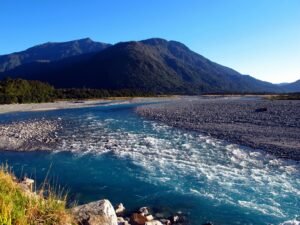
New Zealand’s unique geography and position in the Southern Hemisphere give rise to a diverse range of weather patterns throughout the year. From the warm beaches of summer to the snow-capped mountains of winter, the country offers something for everyone, no matter the season. In this blog post, we’ll delve into the advantages and disadvantages of New Zealand weather by month to help you plan your visit accordingly.
January – The Sunny Start
Advantages:
- Sunny and Warm: January is New Zealand’s peak summer month, with temperatures often exceeding 25°C (77°F) in many parts of the country. This is the perfect time for beachgoers and outdoor enthusiasts to enjoy the sun.
- Long Days: With daylight extending up to 15 hours, you’ll have plenty of time to explore New Zealand’s stunning landscapes and engage in various outdoor activities.
- Festivals: Many festivals and events take place in January, including New Year’s celebrations and music festivals, making it an ideal time for cultural immersion.
Disadvantages:
- Crowds: Given its popularity, January can get crowded, especially in tourist hotspots. Accommodations and popular attractions may be booked well in advance.
- Higher Prices: Peak season means higher prices for accommodation, flights, and rental cars. Be prepared for increased costs.
- Sunburn Risk: The strong sun can lead to sunburn, so don’t forget sunscreen and protective clothing.
February – The Warm Continuation
Advantages:
- Warm Weather: February maintains the warm temperatures of January, making it another great month for outdoor activities and exploration.
- Less Crowded: Crowds begin to thin out compared to January, providing a more relaxed experience at popular destinations.
- Water Activities: Warm waters and sunny weather make February perfect for water-based activities such as swimming, snorkeling, and kayaking.
Disadvantages:
- Variable Weather: While generally warm, February can still see the occasional rain or cool day. Be prepared for changing weather conditions.
- Limited Availability: Although less crowded, some accommodations and tour options might still be booked up from January, so book in advance.
March – The Autumn Arrival
Advantages:
- Mild Weather: March brings cooler temperatures but still maintains pleasant conditions for outdoor activities. It’s an excellent time for hiking and exploring nature.
- Lower Prices: As the peak season ends, you can often find better deals on accommodations and tours in March.
- Fall Foliage: Witness the stunning autumn foliage as trees change color, especially in regions like Central Otago and Canterbury.
Disadvantages:
- Unpredictable Weather: March can bring a mix of weather, including occasional rain and cooler days. Bring layers and rain gear.
- Shorter Days: Days start getting shorter, so plan your activities accordingly and expect reduced daylight hours.
April – The Cozy Cooler Month
Advantages:
- Less Crowded: April is one of the quieter months for tourists, allowing for a more relaxed experience at popular attractions.
- Crisp Weather: Enjoy the crisp, cool weather perfect for hiking and exploring. It’s also a great time for wine tours in regions like Marlborough and Hawke’s Bay.
- Lower Prices: Like March, April offers better deals on accommodations and tours.
Disadvantages:
- Cooler Temperatures: While still pleasant, April can be chilly, especially in the South Island. Pack warm clothing for the evenings.
- Easter Holiday: Easter holidays can bring a slight increase in tourists, so plan accordingly.
May – Chilly Autumn Begins
- Advantages: Mild temperatures, beautiful autumn foliage, fewer tourists.
- Disadvantages: Cooling weather, occasional rain, shorter days.
June – Winter Begins
- Advantages: Snow sports opportunities, fewer crowds, lower prices.
- Disadvantages: Cold temperatures, especially in the South Island, shorter daylight hours.
July – Mid-Winter
- Advantages: Excellent for snow sports and winter activities.
- Disadvantages: Cold, especially in the mountains, limited daylight, potential road closures.
August – Winter Continues
- Advantages: Snow sports continue, fewer tourists.
- Disadvantages: Cold weather, shorter days, some attractions may close.
September – Spring Awakening
- Advantages: Spring blooms, milder temperatures, good for hiking.
- Disadvantages: Unpredictable weather, lingering winter conditions in some areas.
October – Spring Blooms
- Advantages: Blooming landscapes, increasing temperatures, more daylight.
- Disadvantages: Spring showers, variable weather.
November – Spring Blossoms
- Advantages: Pleasant weather, blossoming flora, ideal for outdoor activities.
- Disadvantages: Occasional rain showers, increasing tourists.
December – Summer Beckons
- Advantages: Warmer temperatures, the onset of summer, outdoor festivals.
- Disadvantages: Crowds begin to increase, higher prices, occasional rain.
Conclusion
New Zealand’s weather varies significantly by month, offering unique advantages and disadvantages throughout the year. Ultimately, the best time to visit depends on your preferences and interests. Whether you seek summer sun, autumn foliage, or quieter crowds, New Zealand has something to offer in every season. Be sure to plan ahead, stay informed about the weather forecast, and pack accordingly for a memorable experience in this stunning country.




